Search myodfw.com
The California ground squirrel is a large, long-tailed gray squirrel with a large, nearly-black, triangular patch between light-gray shoulder patches. The gray dorsal pelage is speckled with buffy white spots. The tail is bushy, but not so full and spreading as those of tree squirrels. In Oregon, it occurs throughout the area west of the Cascade Range and throughout much of Central Oregon. It is considered among the most generalized of the ground squirrels as it inhabits a variety of habitats. Although it is a ground-dwelling squirrel, it has a strong propensity to climb. It is commonly observed sitting on
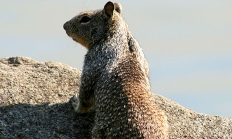
Belding's ground squirrel is a medium-sized ground squirrel without spots, stripes, or splotches. The pelage is smoky gray with some pinkish on the face, feet, and venter, and with a more or less well-defined reddish or brownish band in the middorsal region. The tail is cinnamon on the ventral surface. This squirrel occurs south and east of a line connecting Enterprise, Heppner, Maupin, Wasco Sisters, Diamond Lake, and south to Fish Lake. It may occur in steppe and shrub-steppe area, particularly in meadows; sagebrush flats; and small-grain pasture , and hay-crop fields, and sometimes in openings in woodlands. The Belding's
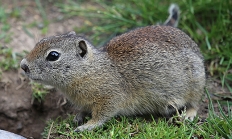
Columbian ground squirrels occur in the Wallowa and Blue Mountains in small openings and meadows in forested areas. Most of these areas flood each spring so the ground squirrels are restricted to the edges of meadows or to mounds within them. Columbian ground squirrels spend an average of 245-255 days in torpor and an average of only 69-94 days active. While above ground, they spend more time alert than in any other activity. This ground squirrel engages in a greeting behavior that resembles kissing, touching mouth and nasal areas usually for one to five seconds before other social behavior. Photo
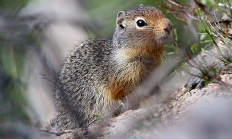
The Wyoming ground squirrel is a medium-sized ground squirrel without spots, stripes, or splotches. The dorsal pelage is grayish with a slight buffy wash. In the field, it appears distinctly more yellowish than other ground squirrels that it might be confused with. The tail is usually longer, as well. This ground squirrel is found in southeastern Oregon and emerges from hibernacula in the spring and by late July has again entered torpor. During the active season, individuals usually become active within an hour after sunrise. Photo by Andrew Hoffman, Flickr
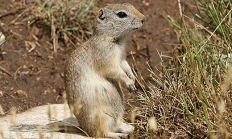
The golden-mantled ground squirrel doubtlessly is the most distinctively marked ground squirrel in Oregon; a white stripe bordered on both sides by a black stripe extends from the shoulder to the hip. From nose to nape above the eye, the head is russet. The back between the stripes is grizzled dark grayish-brown becoming less grizzled on the rump; lateral to the stripes the color grades to a light buffy-gold on the venter. The face, shoulders, front legs, and feet are a bright orangish-gold. This ground squirrel occupies the east slope of the Cascade Range and most of central Oregon, and
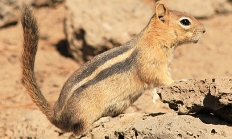
Merriam's ground squirrel is one of the two small gray ground squirrels in Oregon without stripes or spots. Most of the geographic range of this squirrel is in Oregon, where it occurs south and east of a line connecting Huntington, North Powder, Maupin, Warm Springs, Bend, and Fort Rock, Summer Lake, and Plush. This species does not occur south of the North Fork Owyhee River in Malheur County. These ground squirrels emerge in early March, breed, rear their young, become exceedingly fat and go into their hibernacula by early August. Photo by ©John Rakestraw

The Washington ground squirrel is the smaller of the two short-tailed, spotted ground squirrels in Oregon. The dorsum has squarish grayish-white spots on a background of pale smoky-gray with a pinkish wash to brownish gray. This squirrel is endemic to the Deschutes-Columbia Plateau Province east and south of the Columbia River and east of the John Day River. A colonial species, it emerges from dormancy in January to early March, males before females. At the approach of a potential threat, the Washington ground squirrel produces a soft, lisping whistle. Other members of the colony respond by standing upright, repeating the

The Western gray squirrel is the largest tree squirrel in the state. It occurs from central Wasco, Jefferson, Deschutes, and Klamath counties west, except for unforested portions of the Willamette Valley, to central Washington, Benton, Lane, Douglas, Coos, and Curry counties. It is commonly associated with mixed forest communities. These squirrels are wary and secretive, but curious; they examine new objects placed in their environment but, once captured, they often avoid live traps. Western gray squirrels are an Oregon Conservation Strategy Species in the Willamette Valley ecoregion. Photo from ODFW

The Eastern fox squirrel is among the larger of the tree squirrels in Oregon. Its body is the typical squirrel shape. The ears are short, rounded, and without tufts. The tail is flattened and somewhat fluffy. In Oregon, it has been found in Multnomah, Washington, Marion, Lane, Union, Clackamas, Yamhill and Baker counties, all occurring in urban areas or in association with nut orchards. The Eastern fox squirrel is active throughout the year during daylight with its greatest activity in the early morning and late afternoon. During autumn, they are exceptionally active on the ground, scatter-hoarding nuts and acorns as

The Douglas' squirrel is one of the smaller tree squirrels in Oregon. The color and markings of this squirrel differ individually, geographically and seasonally, appearing a dusky olive to brownish gray with an indistinct band of reddish brown with a blackish band along the flanks. In Oregon, it occurs in coniferous forests from the Pacific coast to as far east as western Baker County. Douglas' squirrels are active during the daylight hours year-round, although they may remain in their nests or tree dens for a day or two during inclement weather. Photo by Kathy Munsel, ODFW
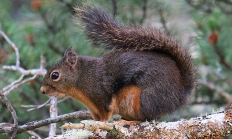
The red squirrel is also a small tree squirrel, only slightly larger than the Douglas' squirrel. They occur in the montane forested portions of Wallowa, Union, Umatilla, Morrow, Malheur and Baker counties. It is a largely arboreal, forest-dwelling species and although often occupying areas vegetated by other conifers, it is associated most frequently with lodgepole pine. Activity patterns of red squirrels are similar to those of Douglas' squirrels. Much activity is directed toward foraging, gathering and catching cones, feeding, and resting. Photo by Shawn Nystrand, Flickr
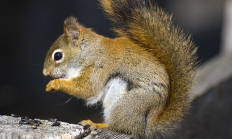
The Northern flying squirrel is the smallest arboreal squirrel in Oregon. It is typically squirrel-like except that the fore- and hind legs are connected by a furred patagium that extends from the ankle to the wrist. It is lead colored with buffy brown to brown tips. It occurs in forested areas west of the Cascade Range and eastward to near Lakeview, Lake County and Paulina Lake, Deschutes County. The species also occurs in the Blue, Ochoco, and Wallowa mountains. Northern flying squirrels are mostly nocturnal although individuals may be observed abroad during light hours on rare occasions. They are usually
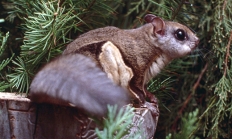
Oregon has five species of pocket gophers that are specially equipped for digging and tunneling. They have large-clawed front paws with small eyes and ears. Sensitive whiskers help them navigate underground.
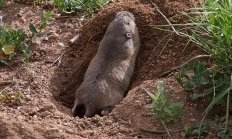
The Botta's pocket gopher tends to be dark rusty-ocherous on the dorsum and light buffy-ocherous on the venter; the nose is dusky and the feet and chin are white. This pocket gopher is territorial; only during the breeding season can more than one individual be found in the same burrow system. Burrow systems do not cross each other, but spacing within and between burrow systems is remarkably uniform. In Oregon, this gopher occurs as disjunct populations: one in Curry County only, the other in southwestern Klamath County, southern Jackson County, and western Josephine County, with an extension through central Douglas
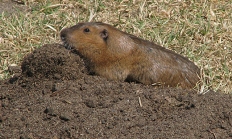
The camas pocket gopher is the largest member of the genus, although large size is not a distinctive feature of the species. This gopher is a dark, sooty brown on the dorsum; the ears and nose are blackish. The venter is lead colored except for an irregular and variable-shaped patch of white on the throat. The winter pelage is long and furry; the summer pelage is short and coarse. The camas pocket gopher is one of the most vicious animals known for its size. Nevertheless, these pocket gophers flee from potential predators whenever the opportunity arises. This pocket gopher produces

The Western pocket gopher is one of the two small pocket gophers in Oregon. Depending on the region, the pelage of this gopher ranges from pure black with purplish and greenish overtones to brown to hazel to yellowish hazel on the dorsom and from lead colored to buff to ocherous on the venter. The face is lead colored to black. The Western pocket gopher constructs burrows beneath the surface with a vertical tunnel connecting deeper burrows that include the nest. This gopher occurs from the Columbia River to the California-Oregon border in the Coast Range and along the coast. It
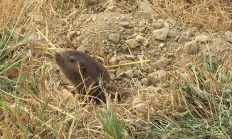
The Northern pocket gopher is the other small pocket gopher in Oregon. Its dorsal pelage ranges from a rich brown to a yellowish brown or buffy gray; the venter is lighter and usually washed with buff. This gopher builds extensive burrow systems which consist of both near-surface and deep runways connected by a vertical shaft. The nest cavity is commonly situated in the deep runway with blind tunnels radiating from near the nest that are used for food storage and as a latrine. The Northern pocket gopher occurs throughout Oregon east of the Cascade Range.

This group of rodents includes mice, voles, rats and muskrats of various sizes, but they all share one trait - their dentition is highly specialized for gnawing.
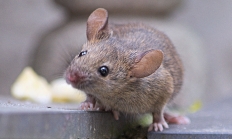
The Little pocket mouse is one of the smallest rodents in North America and certainly the smallest in Oregon. The dorsal pelage is pinkish buff to ocherous buff with overlying blackish hairs; the venter is buff. The tail is bicolored. In Oregon, this mouse occurs in Harney and Malheur counties. They exhibit their greatest activity from spring through autumn and spend a large portion of their lives in burrows below the surface of the ground. In winter, they remain underground continuously, relying on stored seeds for energy. When active on the surface, a large portion of their time is spent

The Great Basin pocket mouse is the largest member of the genus in Oregon. The dorsal pelage of this mouse is pinkish buff or ocherous buff overlain with black hairs; the venter is white to buffy. A lateral line, usually somewhat olive colored, separates the dorsal and ventral pelages. The tail is distinctly bicolored. In Oregon, it occurs thought east of the Cascade Range, except it does not occur in the Wallowa and Blue mountains. The Great Basin pocket mouse constructs burrows below the surface that contain granaries for storage of food, a nest cavity, and several entrances. They spend

